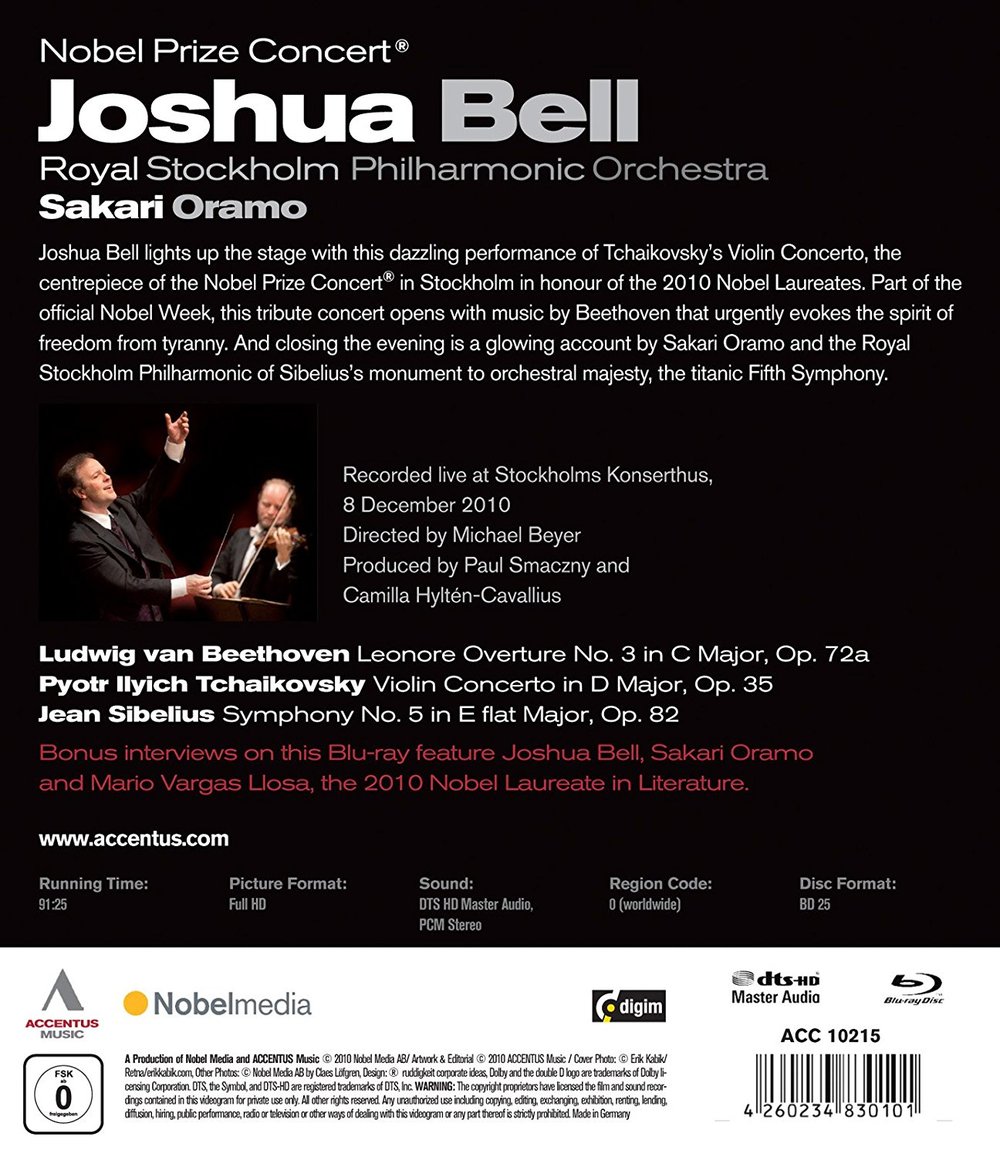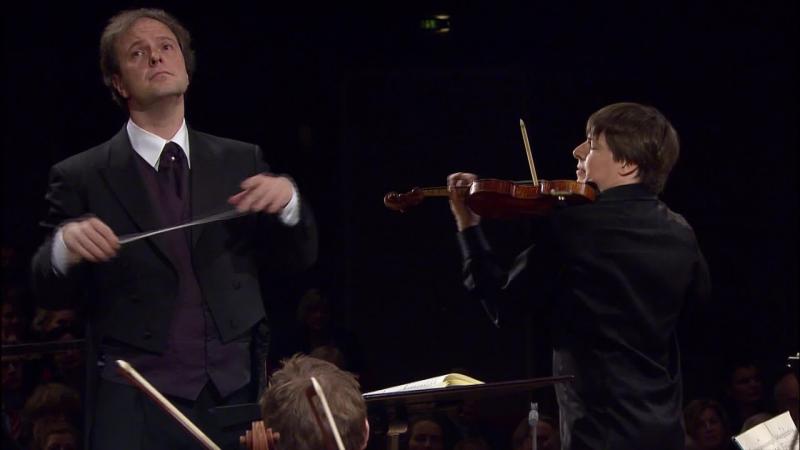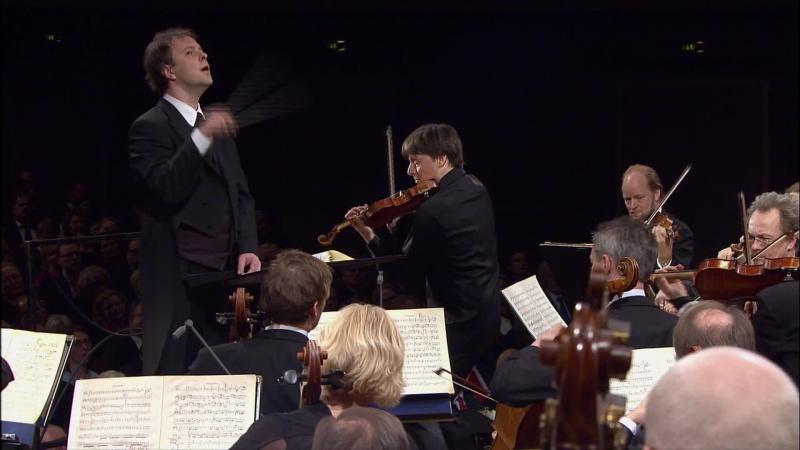

Tchaikovsky Violin Concerto and Sibelius Symphony No. 5 concert. The Beethoven Leonore Overture No. 3 is also on the program. This was the 2010 Nobel Prize Concert performed at the Stockholm Konserthus. Joshua Bell is soloist for the violin concerto. Sakari Oramo conducts the Royal Stockholm Philharmonic Orchestra. Directed for TV by Michael Beyer; produced by Paul Smaczny and Camilla Hyltén. Released 2011, disc has 5.1 Dolby Digital and dts-HD sound. Grade: A for Violin Concerto. Grade D for Sibelius Symphony No. 5.
In the audience for the Nobel Prize concert was the Swedish royal family and tons of smart people there to receive Nobel prize checks. The video editors often include shots of famous people in the audience. The only problem is that I rarely know who they are. I wish the publishers would identify somehow the famous people they highlight!
I originally auditioned this title back in 2011 and wrote a short, superficial review. This was before we decided how grade a video of a violin concerto. I was also completely stumped by Sibelius. So now it's time to improve this review. The next screenshot below is a nice opening whole-orchestra shot that lets you see where all the different instruments are located (playing Leonore Overture No. 3 as warm-up):
Tchaikovsky Violin Concerto
The next two shots of Bell are called "realistic" because they can be seen by members of the live audience:
This view is too close for a member of the audience to see. But we still call this "realistic" because it clearly shows bowing and fingering:
Shots from the back are unrealistic:
And this shot is also unrealistic because you can't see the strings clearly:
Oramo makes a lot of faces:
Bell pours fierce energy into his performance, and soon the sweat begins to flow. Did the Nobel Prize administration turn up the heat in the hall?
Bell seems to perform faultlessly and with perfect taste no matter how fast the tempo:
At the end he's bathed in perspiration. The crowd responds with a standing ovation:
I did a Wonk Worksheet (sorry, now lost—trust me or check me by running your own worksheet). There are 36 minutes of music divided into 208 video clips. This yields the pace of 10.3 seconds per clip.
Here's the clip breakdown:
Conductor shots = 12
Conductor-over-backs shots = 15
Soloist not realistic = 31
*Soloist realistic = 71
Solo and other small-scale clips = 65
*Large-scale clips = 2
*Part-orchestra clips = 2
*Whole-orchestra clips = 4
Instrument-only clips = 6
There are only 79 "supershots" (add up the * numbers above of 71+2+2+4). So the supershots are 38% of the total clips (79/208). Conductor shots total 27, and conductor shots use up 13% of the clips (27/208). The realistic shots of Bell make up 70% of all the soloists shots in the video.
HDVDarts.com has established the following rules-of-thumb to identify a Blu-ray with DVDitis:
“A good symphony HDVD should have a slow pace with more than 10 seconds per video clip on average. 20 to 40% of the clips should be large-scale "supershots." Conductor shots should be less (way less really) than 20% of the clips in the video. When there is a star soloist, at least 50% of the soloist shots should be realistic.”
Subject concerto passes all our video content tests convincingly. This is an impressive showing for Michael Beyer whom we have marked down for DVDitis many times. It may be the best showing for good video content that I've seen from a Western fine-art video publishing company.
Now for a grade. I start with A+ and reduce the grade to A for lack of 96kHz/24-bit sound sampling. In the past I was turned off by Bell's wild appearance after the sweat starts to flow. But if this didn't bother the live audience, why should it bother me? Bell plays with fantastic speed, power, and accuracy as a result, at least in part, of substantial physical exertion. All this makes up for any quibbles I might have over PQ or SQ, so I leave the grade at A.
Sibelius Symphony No. 5
My impression now is that the Sibelius symphonies are a special case. Even the greatest orchestras are going to have difficulties unless they have received special instruction and drilling in how to play them. Each theme in Sibelius has to be pursued relentlessly and with a style that involves a precision of execution rarely otherwise encountered in Western classical music.
I base this feeling on my listening to all the Sibelius symphonies as conducted by Hannu Lintu in his Sibelius box set that we reviewed in 2016. When I first started listening to Lintu's Sibelius, I felt the music was too urgent. But soon I started to catch on. Since then I've encountered other conductors doing these symphonies, and they all sound muddled. In much or most of Western music, there's room for conductors to mold and shape the performance of a piece in various ways that might be quite different but all arguably valid. Sakari Oramo tried mightily to lead the Royal Stockholm band with his concept of Sibelius S5; but to me, the performance sounded disjointed and inadequate. I think when you see a Philip Glass score, you know you have to do it a particular way. Maybe the same thing in true to some extent in with the Sibelius symphonies.
I also did a Wonk Worksheet on Oramo's Sibelius S5. I'll not detail the statistics here except to say that this record flunks all the tests for a good HD video of a symphony. The pace is too fast, there are too few large-scale supershots, and there are way too many conductor clips. PQ, while good in 2011, is now a tad obsolete with soft resolution and dull color balance. The SQ is close to the CD standard. So with these technical demerits, a poor performance, and all those faces from Oramo, I wind up with a D grade for this Sibelius S5.
OR













